- By Richard Meagher
- Business & Technology
 Print
Print
Getting Untangled
Now that we have covered some basics on different wireless networking specifications like 802.11 and what they mean to you as a buyer of home wireless networking – we are ready to move on to second part of three articles on Wireless Home Networking.
Gee, can’t remember?
G is for High Speed Gear
Next, your computer would most likely have what is referred to as an NIC or Network Interface Card. This card connects to the cable modem using what is called a CAT (short for Category) 5 cable. It looks just like a thick telephone line with larger jacks. The NICs come in two varieties, one for desktop PCs and one for portable laptops. If you have a desktop PC, it may have been purchased or later installed with a PCI card similar to the one shown below. If not, you may be using a USB adapter plugged into the USB port.
If you are a mobile user with a laptop, chances are that your trusty road companion may have been born with an NIC installed and ready to connect to a network. If not, you are probably using a credit card sized adapter that slides into a slot or a USB adapter similar to the desktop version.
What we have described is a very basic network that consists of three main ingredients needed to connect to the internet: a. a modem which is also a referred to as a gateway to the internet, b. an interface card in your desktop or laptop and c. the cable linking a. and b.
In the last article, I discussed a scenario where you could be a victim of your spouse’s – oops – I mean a home office makeover. After all the hard work making your office look like you won a Better Homes & Garden sweepstakes. There is no way you are going to ruin it with cables running everywhere and drilling holes or scrapping knees in the crawlspace to try and hide them. Starting with the basic network, all you will need is to add a wireless router and a wireless NIC to reconnect to the Internet.
Let’s start with the router. The router acts as a hub and switch in a network. It allows multiple computers to connect (hub) and controls data traffic between each computer and between networks of computers (switching). In a home networking set-up, the router connects your home network with one or more computers connected, to the cable modem which connects to another network – the Internet. That is what a router does, it connects networks of computers.
You will find a lot of wireless routers on the market that can handle both wired and wireless connections. A popular home network wireless router model has 4 - 10/100Base-T Ethernet ports. What this means is you can connect up to 4 computers to the router using CAT 5 Ethernet cables as well as connect other computers with wireless interfaces. The following are some popular examples of routers you will find at your favorite retailer.
NetgearWireless RouterWGR614 Buffalo TechnologyAirStation Turbo G High Power Wireless WHR-HP-G54 AppleAirport Base Station(Both Windows XP and Mac OS X systems)
If you think wireless and wired routers look alike, you are right. The only obvious difference you will see between wireless and wired only routers are the twin or single antennas that the wireless routers have. Of course, the circuitry is different and the flashing light panel has one more light for wireless signal.
Next Week we'll connect computers to the network.
----
v1i16
Now that we have covered some basics on different wireless networking specifications like 802.11 and what they mean to you as a buyer of home wireless networking – we are ready to move on to second part of three articles on Wireless Home Networking.
In the first article, I explained what the letters A, B & G refers to on the packaging containing the different wireless components and which one you should focus on when buying wireless gear.
Gee, can’t remember?
G is for High Speed Gear
In case you forgot, we should look for the 802.11g stuff. Anything with g also great for high-speed connection. 802.11b devices are still available, but may not be easy to find or as plentiful since they are much slower.
Before getting started, take stock of what you already have. It doesn’t matter whether or not you have any type of networking, wired or wireless. First start with the cable modem, that’s the little box the cable or DSL service usually provides at the end of the cable coming out of the wall where it was installed.
 | Cable Modem (Motorola) |
Next, your computer would most likely have what is referred to as an NIC or Network Interface Card. This card connects to the cable modem using what is called a CAT (short for Category) 5 cable. It looks just like a thick telephone line with larger jacks. The NICs come in two varieties, one for desktop PCs and one for portable laptops. If you have a desktop PC, it may have been purchased or later installed with a PCI card similar to the one shown below. If not, you may be using a USB adapter plugged into the USB port.
 |  |
| USB Adapter (Linksys) | PCI Card (Linksys) |
If you are a mobile user with a laptop, chances are that your trusty road companion may have been born with an NIC installed and ready to connect to a network. If not, you are probably using a credit card sized adapter that slides into a slot or a USB adapter similar to the desktop version.
What we have described is a very basic network that consists of three main ingredients needed to connect to the internet: a. a modem which is also a referred to as a gateway to the internet, b. an interface card in your desktop or laptop and c. the cable linking a. and b.
In the last article, I discussed a scenario where you could be a victim of your spouse’s – oops – I mean a home office makeover. After all the hard work making your office look like you won a Better Homes & Garden sweepstakes. There is no way you are going to ruin it with cables running everywhere and drilling holes or scrapping knees in the crawlspace to try and hide them. Starting with the basic network, all you will need is to add a wireless router and a wireless NIC to reconnect to the Internet.
Let’s start with the router. The router acts as a hub and switch in a network. It allows multiple computers to connect (hub) and controls data traffic between each computer and between networks of computers (switching). In a home networking set-up, the router connects your home network with one or more computers connected, to the cable modem which connects to another network – the Internet. That is what a router does, it connects networks of computers.
You will find a lot of wireless routers on the market that can handle both wired and wireless connections. A popular home network wireless router model has 4 - 10/100Base-T Ethernet ports. What this means is you can connect up to 4 computers to the router using CAT 5 Ethernet cables as well as connect other computers with wireless interfaces. The following are some popular examples of routers you will find at your favorite retailer.
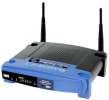 | 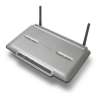 | 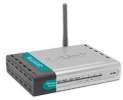 |
| Linksys Wireless Router WRT54G | BelkinWireless G-Plus Router F5D7231-4 | D-LinkWireless Router DI-524 |
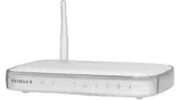 | 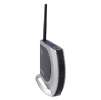 | 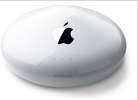 |
| Netgear Wireless Router WGR614 | Buffalo Technology AirStation Turbo G High Power Wireless WHR-HP-G54 | Apple Airport Base Station (Both Windows XP and Mac OS X systems) |
NetgearWireless RouterWGR614 Buffalo TechnologyAirStation Turbo G High Power Wireless WHR-HP-G54 AppleAirport Base Station(Both Windows XP and Mac OS X systems)
If you think wireless and wired routers look alike, you are right. The only obvious difference you will see between wireless and wired only routers are the twin or single antennas that the wireless routers have. Of course, the circuitry is different and the flashing light panel has one more light for wireless signal.
Next Week we'll connect computers to the network.
----
v1i16




